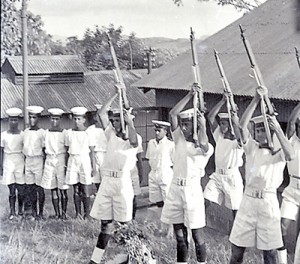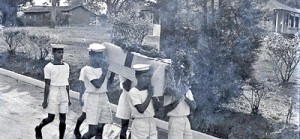We the keepers of the “Mad dogs and Englishmen” traditions!
It was in early February, 1960 that I joined the good ‘ship’ Rangalla, firmly anchored in Diyatalawa. Three of us had been commissioned ‘Instructor Lieutenants’ a couple of weeks previously (a fourth was in the pipeline) and sent to find our sea-legs in the hills.

Solemn procession: Trainee recruits carry A/B Rani’s coffin to the funeral
A naval shore establishment is deemed a ‘ship’ for administrative purposes and fondly called “a stone frigate”. There were more such nicknames: we Instructor Officers were called “Schooleys” – no offence was meant, but it took time to get used to it! Of course, only the Commanding Officer (C.O.) or senior officers would address us as such, though others would refer to us as ‘schooleys’.
“Rangalla” was situated in one of the old British camps – “Uva” camp – almost fronting the Haputale-Bandarawela by-pass when it dipped into the valley of the garrison town. It was a compact, lovely place, quite self-contained. The Army, Navy and Air Force lived amicably in this garrison town with a little row of shops (Army and Navy Stores, Abram Saibo’s) to service them. There was the Survey Dept. too. Among other civilian government servants was the Public Health Inspector who infuriated the Army Sergeants by wearing a khaki uniform with a peak cap and epaulettes carrying the insignia of the Caduceus: Sergeants instructed raw Army recruits were to salute anybody who sported a peak cap “except for that chap there, with two worms round a stick, on his shoulder”!
Our C.O. was Lt. Cdr. (later Commander) Darley Cunningham Ingleton (aka ‘Inky’), a wartime CRNVR Officer. He was given the task of training us Schooleys – an unenviable one because he had no-one to entrust us to. So he made various ‘odd-bods’ give us lectures: the Cadet Training Officer (“Dizzy” Dissanayake), the First Lieutenant (“Pop” Paulusz), the Supply Officer (George Goonewardene), the Recruit Training Officer (Mahasen Weliwitigoda) and himself. He used some senior sailors, too. We were inducted into such matters as “Wardroom Etiquette”, “Supply and Stores Procedure”, “Naval Communications”, “Naval traditions and terminology”, “Ship recognition” etc.
The subjects closest to Ingleton’s own heart were Naval Tradition, Parade Ground Drill, and Physical training. We were sent to the Parade Ground whenever either “Mr.” Mahasen Weliwitigoda or “Mr.”Pius Alles could be spared. (Officers commissioned from the ranks were called “Commissioned Officers” and addressed as “Mr”). Weli, gruff, “bearded like the pard” and “full of strange oaths” (as Shakespeare said it) who obviously chaffed at not having a proper deck under his feet (we were informed that the very floor we were standing on was the “deck”), became my font of information of life in the world of the sailors. Boxer, marksman, and hunter, it was he who took me to see Ankeliya and Sokari being performedwithin a spitting distance of Diyatalawa. Pius dressed in immaculate whites, would drill us by the Book. Each day, after reviewing our progress, he would stand us at ease, declaim “Detail!”, and explain the new drill, eyes not on us but far above, reading from the GI’s Manual writ in the skies. He would then demonstrate it to us by numbers. Then it was our turn to mess it up!

A salute for A/B Rani
We were expected to turn up for early morning PT. We had to do the rounds of mess-decks (barracks) at 2000 (“NEVER say 2000 hrs in the Navy!”) with Duty PO and the Quarter Master preceding us giving warning with a call on the ‘Boatswain’s pipe’. Later, we did an unannounced and unaccompanied ‘round’ during the middle watch (0001-4000). We grumbled, but we learnt. Years later when, as Commandant, I did my own rounds of the Naval & Maritime Academy in Mess Dress, preceded by a bigger entourage led by a bugler, I duly inspected the “heads” (‘toilets’ to you) by putting my finger into each bowl as Ingleton had told us we should (Clean ‘Heads’ are a naval obsession): “Never ask a sailor to do what you will not do yourself”.
I gave silent thanks to ‘Inky’.
We had eight Recruit Divisions that were, for the very last time, named after RN battleships: ANSON, ALBION, HOOD, HOWE, REPULSE, RENOWN, VALIANT and VANGUARD. Each had its Petty Officer and Leading Seaman. ‘Inky’ decided that, while Petty Officers’ peak caps gave them an authoritative look, the Leading Seamen (L/S) – dressed like any other sailor with only a “hook” on their sleeves to denote rank – lacked authority. He decided they would carry a swagger-stick under their arms, which would force them to hold themselves up with pride. But Naval Stores did not stock swagger-sticks. Undeterred, he rummaged till he found a brush that was used to clean inaccessible, covered-over drains: it could be extended to any length by screwing on cane extensions, with metal fittings at each end. ‘Inky’ had eight of these extensions sanded-over and polished at each end and – presto! – the Divisional L/S were strutting around like Sergeant-Majors!
As part of our training – and part of the Recruits’ – ‘Inky’ had us carry out “Kit inspections”: of course, that meant we had to be taught how it was done. The recruits had had to lay out all of the “kit” they had been issued with on their bunks, in the prescribed order and, dressed in their best uniforms, to stand by and be inspected. We, ”Schooleys”, walked among these poor souls, with charts in our hand and tried to look as if we knew all about it. We didn’t, and no one was fooled: but we got a bit of experience.
Another chore imposed on us was of carrying out Quarterly Stock-taking of everything from the Galley to the Naval Stores. We had already been inducted into the world of Forms, but now we were introduced to more arcane naval jargon – but which was really “olde English”. I asked the Cook-in-charge to produce an item that was shown on his ledger; an item described as “Kettle, Fish, one”. Instead of a kettle I was shown an oblong saucepan: the Stores Assistant accompanying me discretely whispered that it was, in fact a “Fish kettle”. “ ’Tis a pretty kettle of fish, indeed”, – here I was, in the Ship’s Galley, re-learning the English that only the English spoke! Stock-taking in the Wardroom threw up a bewildering array of strangely shaped glasses, crockery and cutlery. But it was in Naval Stores that I struck gold. Among items ‘condemned’ because of “Fare, Ware and Tare” (a glorious misspelling of “fair wear and tear”) I came across the “Sailmakers’ Palm” (for stitching canvas), “Bull-dog clips” the “Housewife” (pronounced “hussif”), etc. Wednesdays were half-days: that is, it was a “Make and mend” routine. Sailors were supposed to repair their kit on those days and the extra buttons, needles and thread etc. were provided by the ‘hussif’. It was a veritable “practical” in my subjects of English History and Language. I wouldn’t have missed this for worlds. I can’t thank ‘Inky’ enough.
‘Inky’ had this knack of turning every new happening into a teaching opportunity, as was “The Case of the Bagpipers’ Bitch.” We had with us the Navy Bagpipe Band, at the Parade Ground at “Divisions” every morning, where it played the entire repertoire of Scottish melodies. Well, the Bandsmen had a mascot, a white Alsatian bitch who was dearly loved by Inky. According to Regulations, she had to be “borne of the books” of ‘Rangalla’ – that is to say, her name was on the list of the ship’s crew and she was entitled to her rations. So the Supply Officer duly entered her in the Books as “A/B Rani”. Her rating of A/B, he told us over a drink, was not “Able Seaman” as we thought, but “Able Bitch”!
One sad day, Rani died. ‘Inky’ immediately recognized the possibilities of another Training exercise: A/B Rani was to be accorded a funeral with full Naval honours, with Mourning party, Firing party, (all trainee recruits) Band in attendance, Buglers and the “Last Post” and all of us. We were only spared the chore of getting into ceremonial uniforms. There was great consternation and much guffawing in the town and the Army camps but, in this Cantonment town, we were recognized as the keepers of the “Mad dogs and Englishmen” traditions!
Ingleton’s finest hour was around the corner. Rear Adm. Royce de Mel was also the Chairman of the National Olympics Committee. Anticipating conflicting requests for a Manager for our team to the Rome Olympics, he suggested his own, his Staff Sports Officer. So ‘Inky’, who was wearing that cap, too, went to Rome. On his return, he “cleared lower decks” (i.e. stopped all work, all hands on deck to listen to some words of wisdom) and spoke to us about the experience. I can’t remember most of what he said but he ended up with a prediction: “Keep an eye in the future for this remarkable boxer we saw in Rome – a chap called Clay. Cassius Clay”.
Once, in those dog days, I caught a glimpse of how dedicated a good naval officer could be. Cdr. Rajah Proctor, implicated in the murk of the “Far Eastern Booze” and suspended, was holidaying at “Rangalla”. There came another “Emergency” situation and an officer was to be dispatched to NHQ with an armed party. I was the only one available and was told to get ready. Saluting ‘Inky’ with an “Aye aye, Sir”, I was about to leave the office when Proctor spoke. “Schooley”, he said, “I don’t think you know what you are letting yourself in for. You are going with an armed party during a crisis. I cannot tell you all you need to know, but remember what I am telling you……”and he read me a potted tutorial. I was amazed: I am, still. Here was a man waiting for the axe to fall on his service of over 25 years, yet feeling it his duty to tell a neophyte how a naval officer should act in a crisis. How right he was. I never met him again but, as I have said before, “Thank you, Commander Proctor”.
Soon after this, ‘Inky’ was posted elsewhere and “Rangalla” underwent a change. “Pop”Paulusz assumed command. Our Supply Officer was sent to establish a new security post at Laxapana. With no Recruits or Officer Cadets on the horizon, the Navy was left with a bunch of “Schooleys” with no work for them! The time was ripe for a sea-change. The change came and, with it, the birth of a new era.
I must pay a tribute here to Commander Ingleton, a man who was derided by many, but whom I found to be a good leader: a leader being one who shows the way. He was laughed at by the “Dartmouth boys” (who laughed at anyone over the ripe old age of 24), and also by those who had been his juniors in the CRNVR (out of sheer mealy-mouthed jealousy). He was not perfect, he knew his limitations but he strove to excel within those limitations. His life was the Navy and he was one of three wartime CRNVR officers who reverted to the rate of sailor to remain in the 100-man Navy after the war. I have seen him at his best in Diyatalawa and Trincomalee and found him as good – if not better at times – than his would-be detractors. It is with great sincerity that I say that I was fortunate to have been trained by him in my earliest years in the Navy.


